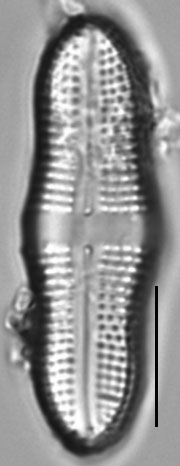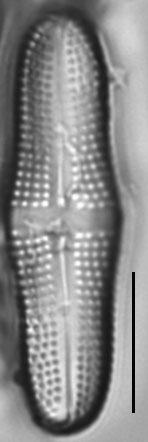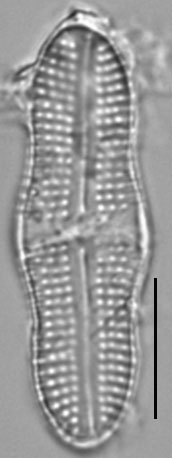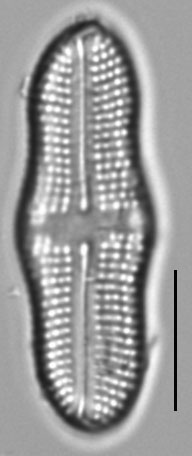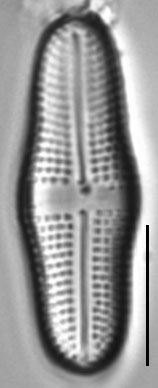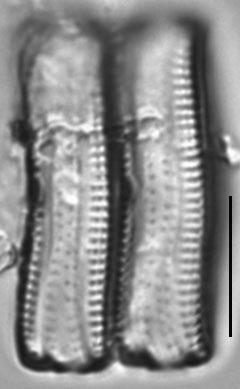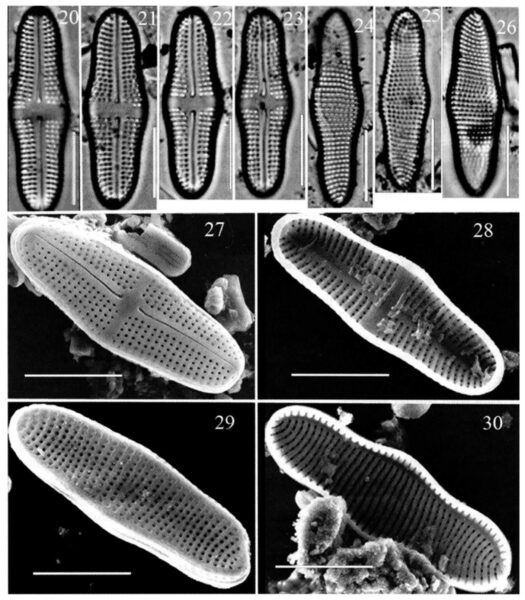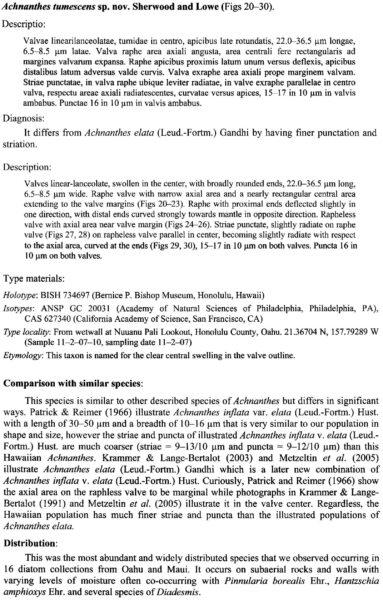Achnanthes tumescens
-
Category
-
Length Range29-37 µm
-
Width Range8.0-9.5 µm
-
Striae in 10 µm14-15 on raphe valve, 12-13 on rapheless valve
-
ContributorRex Lowe - Dec 2011
-
ReviewerSam Rushforth - Jan 2012
Identification
View image metadata
Type
Description
Valves are linear-lanceolate, gibbous in the center valve, with broadly rounded ends.The raphe valve has a narrow axial area and a nearly rectangular central area extending to the valve margins. The proximal raphe ends are deflected slightly in one direction, with the distal ends curved strongly toward the mantle in the opposite direction. The axial on the rapheless valve is positioned near the valve margin. Striae are punctate and slightly radiate on raphe valve and parallel in the center. Striae on the rapheless valve are slightly radiate and curved near the apices.
Autecology
Achnanthes tumescens was the most abundant and widely distributed species in collections from subaerial well walls of the Hawaiian islands of Oahu and Maui. It co-occurred with Pinnularia borealis, Hantzschia amphioxys and Diadesmis spp.
-
Size Range, µm3
-
Motility
-
Attachment
-
Habitat
-
Colony
-
Waterbody
- Learn more about this
Original Description
Valves linear-lanceolate, swollen in the center, with broadly rounded ends, 22.0-36.5 µm long, 6.5-8.5 µm wide. Raphe valve with narrow axial area and a nearly rectangular central area extending to the valve margins (Figs 20-23). Raphe with proximal ends deflected slightly in one direction, with distal ends curved strongly towards mantle in opposite direction. Rapheless valve with axial area near valve margin (Figs 24-26). Striae punctate, slightly radiate on raphe valve (Figs 27, 28) on rapheless valve parallel in center, becoming slightly radiate with respect to the axial area, curved at the ends (Figs 29, 30), 15-17 in 10 µm on both valves. Puncta 16 in 10 µm on both valves.
-
AuthorR.L.Lowe and A.R.Sherwood 2009
-
Length Range22.0-36.5 µm
-
Width6.5-8.5 µm
-
Striae in 10µm15-17
Citations & Links
Citations
-
Publication Link: 10.1080/0269249X.2009.9705805
Links
-
Index Nominum Algarum
Cite This Page
Lowe, R. (2011). Achnanthes tumescens. In Diatoms of North America. Retrieved November 21, 2024, from https://diatoms.org/species/achnanthes_tumescens
Responses
The 15 response plots show an environmental variable (x axis) against the relative abundance (y axis) of Achnanthes tumescens from all the stream reaches where it was present. Note that the relative abundance scale is the same on each plot. Explanation of each environmental variable and units are as follows:
ELEVATION = stream reach elevation (meters)
STRAHLER = distribution plot of the Strahler Stream Order
SLOPE = stream reach gradient (degrees)
W1_HALL = an index that is a measure of streamside (riparian) human activity that ranges from 0 - 10, with a value of 0 indicating of minimal disturbance to a value of 10 indicating severe disturbance.
PHSTVL = pH measured in a sealed syringe sample (pH units)
log_COND = log concentration of specific conductivity (µS/cm)
log_PTL = log concentration of total phosphorus (µg/L)
log_NO3 = log concentration of nitrate (µeq/L)
log_DOC = log concentration of dissolved organic carbon (mg/L)
log_SIO2 = log concentration of silicon (mg/L)
log_NA = log concentration of sodium (µeq/L)
log_HCO3 = log concentration of the bicarbonate ion (µeq/L)
EMBED = percent of the stream substrate that is embedded by sand and fine sediment
log_TURBIDITY = log of turbidity, a measure of cloudiness of water, in nephelometric turbidity units (NTU).
DISTOT = an index of total human disturbance in the watershed that ranges from 1 - 100, with a value of 0 indicating of minimal disturbance to a value of 100 indicating severe disturbance.
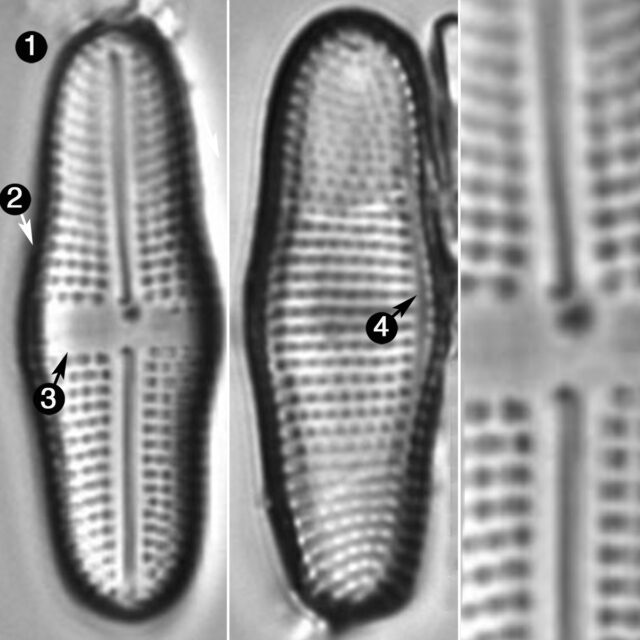
Achnanthes tumescens
- Valves linear-lanceolate
- Central valve gibbous
- Raphe valve with nearly rectangular central area
- Rapheless valve with eccentric axial area
Valves are linear-lanceolate, with a gibbous center and broadly rounded ends. The raphe valve has a nearly rectangular central area that extends to the valve margins. The axial on the rapheless valve is positioned near the valve margin.
 Diatoms of North America
Diatoms of North America